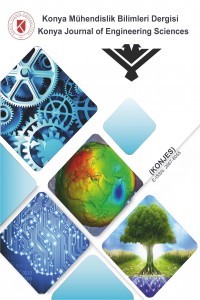SİVAS 4 EYLÜL BARAJI İÇME SUYUNDAKİ MANGANIN LABORATUAR VE TESİS ÖLÇEKLİ GİDERİM VERİMLERİNİN KARŞILAŞTIRILMASI
Sivas kenti, içme ve kullanma suyu ihtiyacının bir kısmını yer altı sularından bir kısmını ise yüzey sularından karşılamaktadır. Sivas 4 Eylül Barajı’ndan temin edilmiş olan yüzey suyu, Sivas Belediyesi İçme Suyu Arıtma Tesisi’nde arıtılmakta ve şehir şebekesine verilmektedir. 4 Eylül Barajı’ndan temin edilmiş olan içme suyundaki mangan konsantrasyonu, sonbahar aylarında (Ekim 2010) artış göstermiştir. Bu çalışmada; içme suyundaki manganı gidermek için laboratuar ortamında yapılan Jar testi çalışmasıyla farklı koagülantlar kullanılarak optimum dozaj ve uygun koagülant seçimi amaçlanmıştır. Jar testi çalışması sonucunda laboratuarda belirlenen en uygun koagülantlar ve optimum dozajlar, içme suyu arıtma tesisinde uygulanmıştır. Koagülant olarak potasyum permanganat (KMnO4), Demir (III) Klorür (FeCl3) ve koagülant yardımcı kimyasalı olarak da Anyonik Polielektrolit kullanılmıştır. Deney sonucunda yalnızca KMnO4 kullanılmasıyla mangan giderim veriminin %94,7 olduğu tespit edilmiştir. KMnO4 ile birlikte FeCl3 ve anyonik polieletrolit birlikte kullanıldığında mangan giderim verimi %96,3 olarak bulunmuştur. Mangan giderme veriminin yüksek olduğu laboratuar ortamındaki optimum koşullar tesiste uygulandığında; laboratuar ölçekli elde edilen uygun koagülant ve optimum dozajın saha ölçeğinde uygulanmasıyla mangan giderim veriminin %53,4 olduğu görülmüştür. Sonuç olarak; yüksek oranlarda mangan giderimi sağlamak için içme suyu arıtma tesisinde, laboratuar ölçeğinde elde edilen dozajlardan daha yüksek dozajlara gereksinim duyulduğu tespit edilmiştir.
Anahtar Kelimeler:
İçme suyu Arıtma Tesisi, Mangan Giderimi, Sivas 4 Eylül Barajı, Jar Testi, Koagülant
Comparison of Manganese Removal Efficiency for Laboratory and Plant Scale in Sivas 4 Eylul Dam Potable Water
Potable and service water demand of the city Sivas is being supplied partly with the underground water and partly with the stored water within the active basin of the Sivas 4 Eylül Dam. Released discharge which is supplied from the Sivas 4 Eylül Dam is at first step treated at the Water Treatment Plant of the Sivas Municipality and then directed to the water reservoirs and the city main water network. It has been observed that manganese concentration within the potable water supplied from the Sivas 4 Eylül Dam has been increasing during the autumn months (October 2010). Within the scope of this study, appropriate coagulant selection and its optimum dosage determination has been targetted for manganese disposal within the potable water by trying different coagulants via Jar test at laboratory medium. Most appropriate coagulant and its optimum dosage which was determined as a conclusion from the Jar test carried out at laboratory has been applicated at the Water Treatment Plant of the Sivas Municipality. (KMnO4); permanganet of potassium as coagulant, (FeCl3); ferric [Iron (III)] chloride and Anionic Polyelectrolyte as coagulant ancillary chemical has been used. As a conclusion of the test it was determined that manganese disposal efficiency had been 94.7% in case only KMnO4 was used. It was found out that manganese disposal efficiency had been 96.3% in case KMnO4 together with FeCl3 and anionic polyelectrolyte were used. When the optimum conditions of the laboratory mediumwhere high manganese disposal efficiencies are observed were applicated in the facility ; it has been seen that manganese disposal efficiency was 53.4% when appropriate coagulant and its optimum dosage basing the laboratory tests were applicated at site. As a conclusion it has been determined that higher dosages than the ones obtained from laboratory tests were required to be applicated at practice in case a high level manganese disposal at water treatment plant facilities was desired.
___
- Avşarer, B., 2007, Mn (II)’nin Atmosferik Oksijenle Oksidasyonuna Organik ve İnorganik Maddelerin Etkisi, Yüksek Lisans Tezi, İstanbul Üniversitesi Fen Bilimleri Enstitüsü, İstanbul, 86 s.
- American Ground Water Trust, 2002, Solutions To Manganese Problems, The American Well Owner, v.1.
- Canpolat, Ö., Çalta, M, 2001, “Keban Baraj Gölü’nde (Elazığ) Yakalanan Acanthobrama Marmid (Heckel,1843)’de Bazı Ağır Metal Düzeylerinin Belirlenmesi”, F.Ü. Fen ve Müh. Bilimleri Dergisi, 13, 2, 263‐268.
- Çil, O.H.S., Alaş, A., 2002, “Aksaray İline İçme Suyu Sağlayan Bazı Kaynaklarda Su Kalite Parametrelerinin İncelenmesi”, Ekoloji Dergisi, Cilt:11, Sayı:42, 40‐44.
- Dönderici, Z.S., Dönderici A., Başar, F, 2010, “Kaynak Sularının Fiziksel Ve Kimyasal Kaliteleri Üzerine Bir Araştırma”, Türk Hijyen ve Deneysel Biyoloji Dergisi, 67(4), 167‐172.
- Gültekin, A.H., 1997, “Mangenez Yataklarının Köken Tespitinde Mineralojik ve Kimyasal Veriler”, Jeoloji Mühendisliği, Sayı 20, 39‐46.
- Özgün, H., 2007, Oksidasyon ve Filtrasyon Aşamalarında Sularda Mangan Giderimini Etkileyen Bazı Faktörlerin Araştırılması, Yüksek Lisans Tezi, İstanbul Teknik Üniversitesi Fen Bilimleri Enstitüsü, İstanbul, 91 s.
- Raveendran, R., Ashworth, B., Chatelier, B., 2001, “Manganese Removal In Drinking Water Systems”, 64th Annual Water Industry Engineers and Operators Conference, Bendigo, p.92‐100.
- Sağlık Bakanlığı Temel Sağlık Hizmetleri Genel Müdürlüğü, İnsani Tüketim Amaçlı Sular Hakkında Yönetmelik, 17 Şubat 2005 tarih, 25730 sayılı Resmi Gazete.
- Talaat, H., Ghaly, M. Y., Kamel, E. M., Ahmed, E. M., Awad, E. M., 2010, “Simultaneous Removal Iron and Manganese from Ground Water by Combined Photo‐Electrochemical Method”, Journal of American Science, vol. 6 (12)
- Yayın Aralığı: Yılda 4 Sayı
- Başlangıç: 2004
- Yayıncı: Konya Teknik Üniversitesi
